Qinwen Deng
A Unifying View of OTFS and Its Many Variants
Feb 13, 2025Abstract:High mobility environment leads to severe Doppler effects and poses serious challenges to the conventional physical layer based on the widely popular orthogonal frequency division multiplexing (OFDM). The recent emergence of orthogonal time frequency space (OTFS) modulation, along with its many related variants, presents a promising solution to overcome such channel Doppler effects. This paper aims to clearly establish the relationships among the various manifestations of OTFS. Among these related modulations, we identify their connections, common features, and distinctions. Building on existing works, this work provides a general overview of various OTFS-related detection schemes and performance comparisons. We first provide an overview of OFDM and filter bank multi-carrier (FBMC) by demonstrating OTFS as a precoded FBMC through the introduction of inverse symplectic finite Fourier transform (ISFFT). We explore the relationship between OTFS and related modulation schemes with similar characteristics. We provide an effective channel model for high-mobility channels and offer a unified detection representation. We provide numerical comparisons of power spectrum density (PSD) and bit error rate (BER) to underscore the benefit of these modulation schemes in high-mobility scenarios. We also evaluate various detection schemes, revealing insights into their efficacies. We discuss opportunities and challenges for OTFS in high mobility, setting the stage for future research and development in this field.
Jamming Suppression Via Resource Hopping in High-Mobility OTFS-SCMA Systems
Sep 01, 2023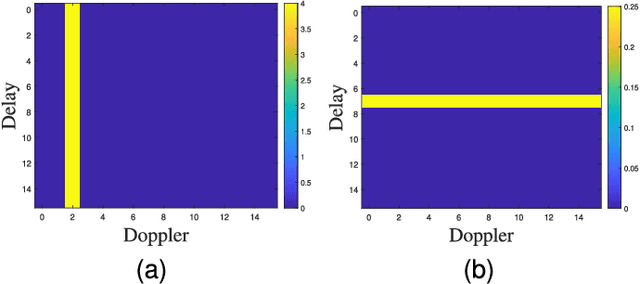

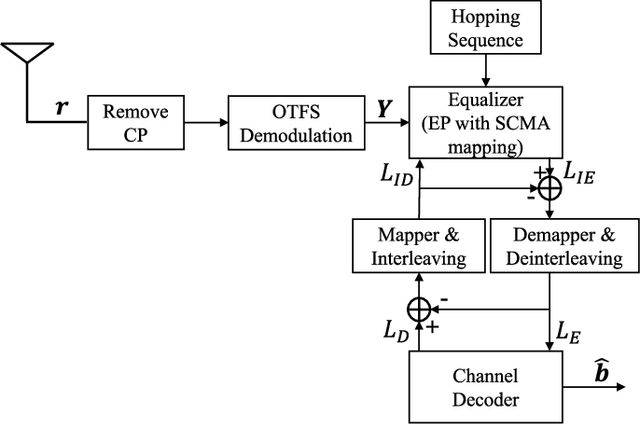
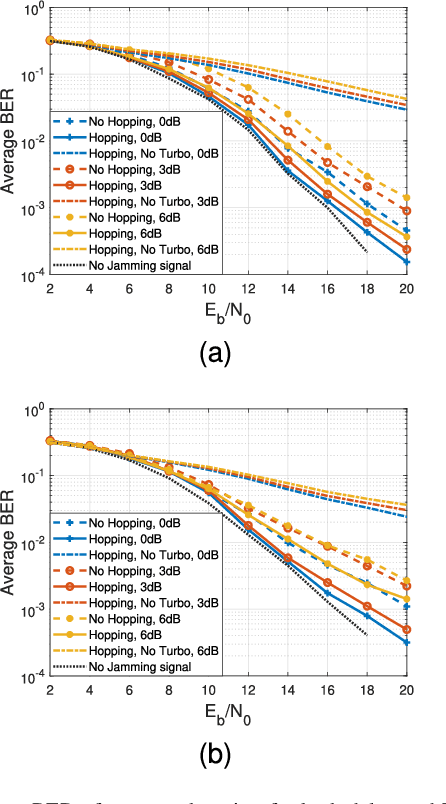
Abstract:This letter studies the mechanism of uplink multiple access and jamming suppression in an OTFS system. Specifically, we propose a novel resource hopping mechanism for orthogonal time frequency space (OTFS) systems with delay or Doppler partitioned sparse code multiple access (SCMA) to mitigate the effect of jamming in controlled multiuser uplink. We analyze the non-uniform impact of classic jamming signals such as narrowband interference (NBI) and periodic impulse noise (PIN) in delay-Doppler (DD) domain on OTFS systems. Leveraging turbo equalization, our proposed hopping method demonstrates consistent BER performance improvement under jamming over conventional OTFS-SCMA systems compared to static resource allocation schemes.
OTFS Signaling for SCMA With Coordinated Multi-Point Vehicle Communications
Feb 17, 2023Abstract:This paper investigates an uplink coordinated multi-point (CoMP) coverage scenario, in which multiple mobile users are grouped for sparse code multiple access (SCMA), and served by the remote radio head (RRH) in front of them and the RRH behind them simultaneously. We apply orthogonal time frequency space (OTFS) modulation for each user to exploit the degrees of freedom arising from both the delay and Doppler domains. As the signals received by the RRHs in front of and behind the users experience respectively positive and negative Doppler frequency shifts, our proposed OTFS-based SCMA (OBSCMA) with CoMP system can effectively harvest extra Doppler and spatial diversity for better performance. Based on maximum likelihood (ML) detector, we analyze the single-user average bit error rate (ABER) bound as the benchmark of the ABER performance for our proposed OBSCMA with CoMP system. We also develop a customized Gaussian approximation with expectation propagation (GAEP) algorithm for multi-user detection and propose efficient algorithm structures for centralized and decentralized detectors. Our proposed OBSCMA with CoMP system leads to stronger performance than the existing solutions. The proposed centralized and decentralized detectors exhibit effective reception and robustness under channel state information uncertainty.
Hyperspectral Image Segmentation based on Graph Processing over Multilayer Networks
Nov 29, 2021



Abstract:Hyperspectral imaging is an important sensing technology with broad applications and impact in areas including environmental science, weather, and geo/space exploration. One important task of hyperspectral image (HSI) processing is the extraction of spectral-spatial features. Leveraging on the recent-developed graph signal processing over multilayer networks (M-GSP), this work proposes several approaches to HSI segmentation based on M-GSP feature extraction. To capture joint spectral-spatial information, we first customize a tensor-based multilayer network (MLN) model for HSI, and define a MLN singular space for feature extraction. We then develop an unsupervised HSI segmentation method by utilizing MLN spectral clustering. Regrouping HSI pixels via MLN-based clustering, we further propose a semi-supervised HSI classification based on multi-resolution fusions of superpixels. Our experimental results demonstrate the strength of M-GSP in HSI processing and spectral-spatial information extraction.
Graph Signal Processing over Multilayer Networks -- Part II: Useful Tools and Practical Applications
Sep 07, 2021
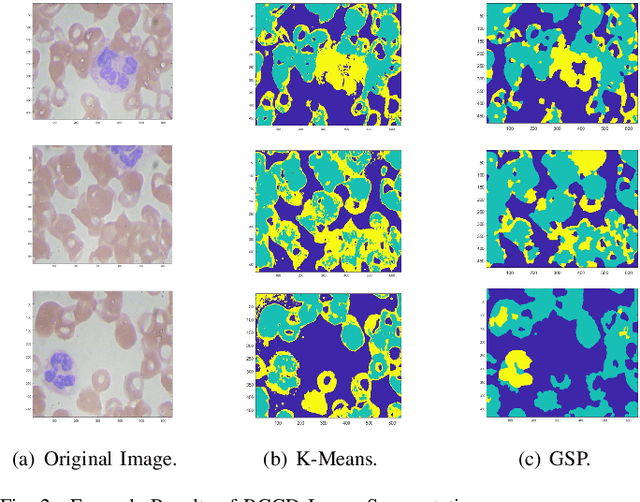
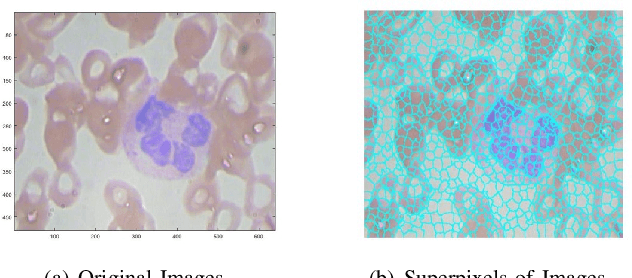
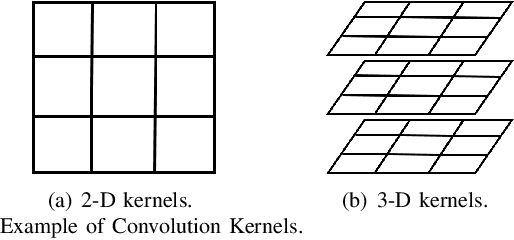
Abstract:This work introduces a tensor-based framework of graph signal processing over multilayer networks (M-GSP) to analyze high-dimensional signal interactions. Following Part I's introduction of fundamental definitions and spectrum properties of M-GSP, this second Part focuses on more detailed discussions of implementation and applications of M-GSP. Specifically, we define the concepts of stationary process, convolution, bandlimited signals, and sampling theory over multilayer networks. We also develop fundamentals of filter design and derive approximated methods of spectrum estimation within the proposed framework. For practical applications, we further present several MLN-based methods for signal processing and data analysis. Our experimental results demonstrate significant performance improvement using our M-GSP framework over traditional signal processing solutions.
Graph Signal Processing over Multilayer Networks -- Part I: Foundations and Spectrum Analysis
Sep 07, 2021



Abstract:Signal processing over single-layer graphs has become a mainstream tool owing to its power in revealing obscure underlying structures within data signals. For generally, many real-life datasets and systems are characterized by more complex interactions among distinct entities. Such complex interactions may represent multiple levels of interactions that are difficult to be modeled with a single layer graph and can instead be captured by multiple layers of graph connections. Such multilayer/multi-level data structure can be more naturally modeled and captured by a high-dimensional multi-layer network (MLN). This work generalizes traditional graph signal processing (GSP) over multilayer networks for analysis of such multilayer signal features and their interactions. We propose a tensor-based framework of this multilayer network signal processing (M-GSP) in this two-part series. Specially, Part I introduces the fundamentals of M-GSP and studies spectrum properties of MLN Fourier space. We further describe its connections to traditional digital signal processing and GSP. Part II focuses on several major tools within the M-GSP framework for signal processing and data analysis. We provide results to demonstrate the efficacy and benefits of applying multilayer networks and the M-GSP in practical scenarios.
An Efficient Hypergraph Approach to Robust Point Cloud Resampling
Mar 11, 2021



Abstract:Efficient processing and feature extraction of largescale point clouds are important in related computer vision and cyber-physical systems. This work investigates point cloud resampling based on hypergraph signal processing (HGSP) to better explore the underlying relationship among different cloud points and to extract contour-enhanced features. Specifically, we design hypergraph spectral filters to capture multi-lateral interactions among the signal nodes of point clouds and to better preserve their surface outlines. Without the need and the computation to first construct the underlying hypergraph, our low complexity approach directly estimates hypergraph spectrum of point clouds by leveraging hypergraph stationary processes from the observed 3D coordinates. Evaluating the proposed resampling methods with several metrics, our test results validate the high efficacy of hypergraph characterization of point clouds and demonstrate the robustness of hypergraph-based resampling under noisy observations.
Point Cloud Resampling Through Hypergraph Signal Processing
Feb 12, 2021



Abstract:Three-dimensional (3D) point clouds serve as an important data representation for visualization applications. The rapidly growing utility and popularity of point cloud processing strongly motivate a plethora of research activities on large-scale point cloud processing and feature extraction. In this work, we investigate point cloud resampling based on hypergraph signal processing (HGSP). We develop a novel method to extract sharp object features and reduce the size of point cloud representation. By directly estimating hypergraph spectrum based on hypergraph stationary processing, we design a spectral kernel-based filter to capture high-dimensional interactions among the signal nodes of point clouds and to better preserve their surface outlines. Experimental results validate the effectiveness of hypergraph in representing point clouds, and demonstrate the robustness of the proposed resampling method in noisy environment.
OTFS Signaling for Uplink NOMA of Heterogeneous Mobility Users
Feb 09, 2021
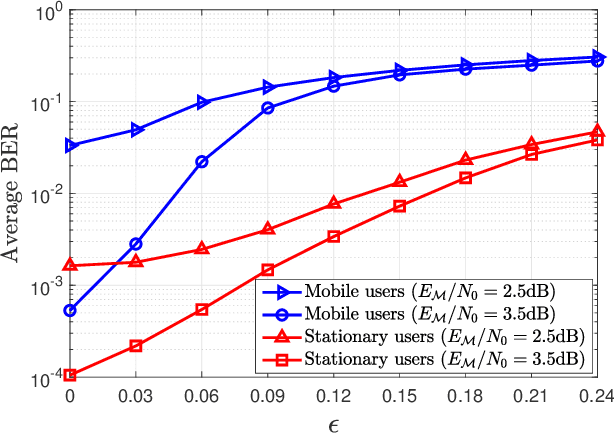
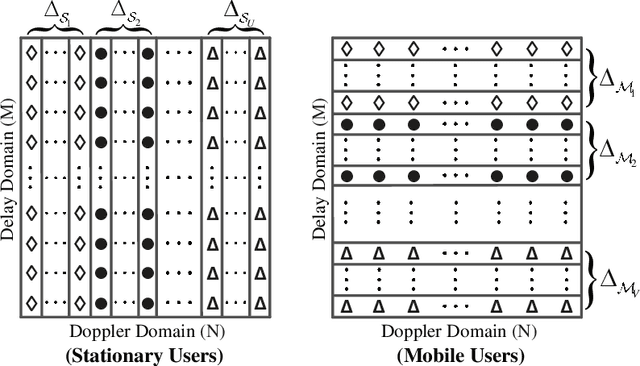
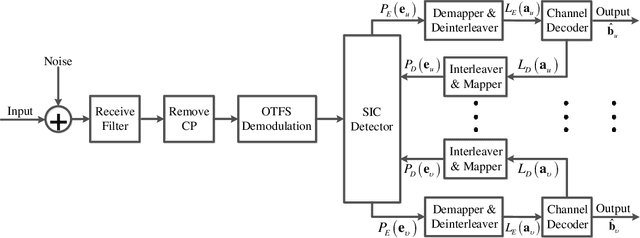
Abstract:We investigate a coded uplink non-orthogonal multiple access (NOMA) configuration in which groups of co-channel users are modulated in accordance with orthogonal time frequency space (OTFS). We take advantage of OTFS characteristics to achieve NOMA spectrum sharing in the delay-Doppler domain between stationary and mobile users. We develop an efficient iterative turbo receiver based on the principle of successive interference cancellation (SIC) to overcome the co-channel interference (CCI). We propose two turbo detector algorithms: orthogonal approximate message passing with linear minimum mean squared error (OAMP-LMMSE) and Gaussian approximate message passing with expectation propagation (GAMP-EP). The interactive OAMP-LMMSE detector and GAMP-EP detector are respectively assigned for the reception of the stationary and mobile users. We analyze the convergence performance of our proposed iterative SIC turbo receiver by utilizing a customized extrinsic information transfer (EXIT) chart and simplify the corresponding detector algorithms to further reduce receiver complexity. Our proposed iterative SIC turbo receiver demonstrates performance improvement over existing receivers and robustness against imperfect SIC process and channel state information uncertainty.
 Add to Chrome
Add to Chrome Add to Firefox
Add to Firefox Add to Edge
Add to Edge